Looking for options: concrete pad detail
So my double stud wall house is mostly framed and its time to start working on the front entry soon. I am having trouble deciding what detail to use for the pad and column footing. Below are 3 options. Does anyone have an opinion on which one is best?
Southern NH
soil is well drained
house is at the site high point, all water drains away
Thanks for looking
James
GBA Detail Library
A collection of one thousand construction details organized by climate and house part












Replies
James,
It's probably a good idea, as you suggest, for the concrete footing for your column base to be as wide as the stone veneer.
To minimize the chance that your patio slab will heave, you need these features:
1. An 8-inch layer of crushed stone under the slab.
2. A 2-inch-thick horizontal layer of rigid foam (EPS would be best) under the slab.
3. Vertical rigid foam (say, 2 inches thick) at the exposed perimeter of the slab (extending 2 feet below grade).
These details cost a little more, but they'll give you added assurance that the slab won't heave.
Martin, Thanks for the reply... A mix of option #2 and #3 good idea!
Just curious? What if any concern do you have with option #3. (assuming spot load calcs are done)
James
James,
Oops. I just realized you posted three illustrations. I only examined the first two illustrations.
IMO, #3 is also a good design and with gravel distributing the column loads, probably doesn't need to be as thick as you show.
Consider putting some rebar between the outside slab and house stem wall - while frost is the big mover, settling and moisture can also cause some differential movement (because the house is supported by highly loaded soil at 5' and the slab is supported by lightly loaded soil/gravel at ~1').
Yes, this causes a little thermal bridging - you could use stainless steel.
James,
I'm sorry that my first response was based on seeing just two of your illustrations.
The basic idea is that you need good drainage under the slab -- hence the need for the crushed stone -- because wet soil heaves while dry rocks don't heave. You also need some rigid foam to retain the heat of the soil, and to prevent that heat from flowing towards to cold slab above.
The third illustration is the best of the three, because it includes rigid foam. Either of three options at the edge of the slap -- (1) extending the insulation horizontally beyond the slab, or (2) extending the insulation at a 45-degree slope beyond the slab, or (3) extending the insulation vertically downward at the slab edge -- will work.
Jon,
Tying the house to the slab is a bad idea. You have fixed one end of something that will see some movement, made of a material that acts poorly in tension. The slab need to be able to settle and move seasonally.
Great input guys! Looks like it's going to be plan #3 with the slab at 8" thick! (Because of my local concrete suppliers minimum delivery charge, this and one other entry pad is all I have to do and its a 4.5 yard minimum)
James,
Make sure that the subgrade is well-compacted, in shallow lifts, with a plate compactor before placing the stone, the rigid foam, and the 8 inches of concrete. If you have differential settling due to the fact that your fill wasn't properly compacted, I'd hate to be the guy who has to demolish that 8-inch slab to repair it.
Martin, Site work is my specialty but compaction reminders are always helpful!
My opinion is that while gravel has various benefits in preventing differential movement/cracking on a given slab (ie, is normally beneficial), when it comes to differential movement wrt something else (say a deep adjacent footing without gravel), it can increase differential movement. Why - because gravel can transport, accumulate and retain water until it can be absorbed by a thick layer of clay. Rocks themselves (wet or dry) don't heave, but wet/dry clay under rocks/gravel can and the gravel will transmit the movement upwards.
In this case, I'd omit the gravel, reducing possible compaction and moisture change issues.
Jon R- in this case could xps be use to slope away the water and also possibly poly over that. there by avoiding the differential movement/cracking